Gaming Performance
The big question here is whether or not the CPU is going to be the bottleneck with the selected graphics card. As you'll see, the processor can be a limiting factor in the stock systems, depending on the game, but once we start overclocking everything begins to even out.

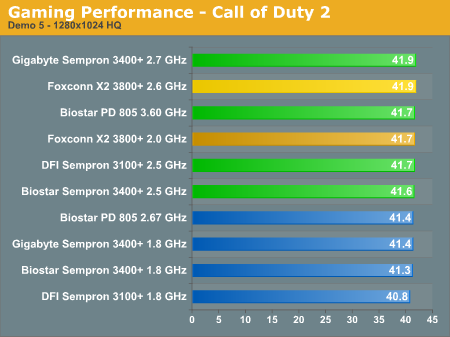
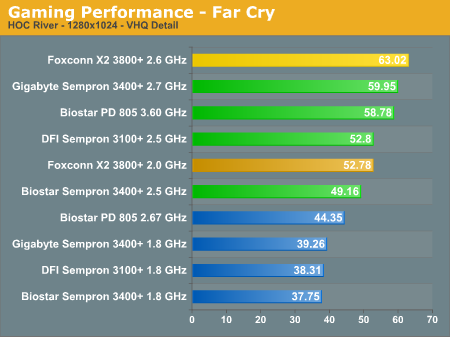
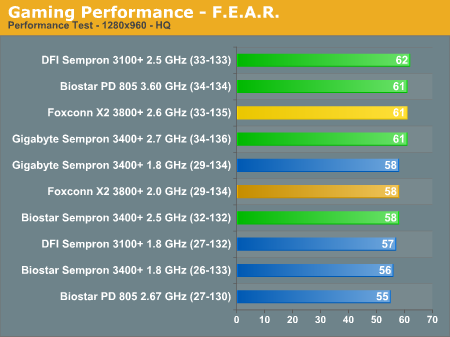
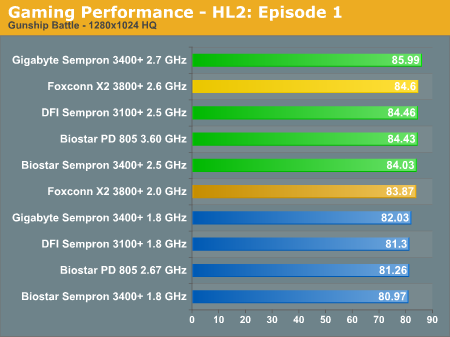

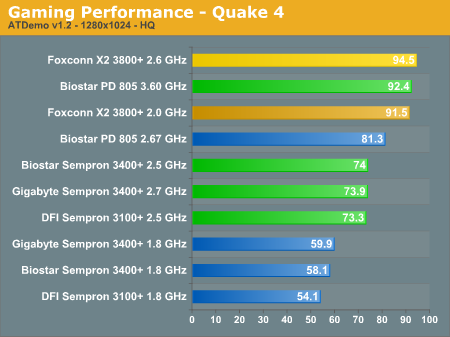
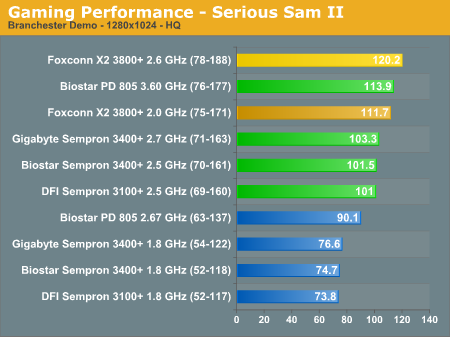
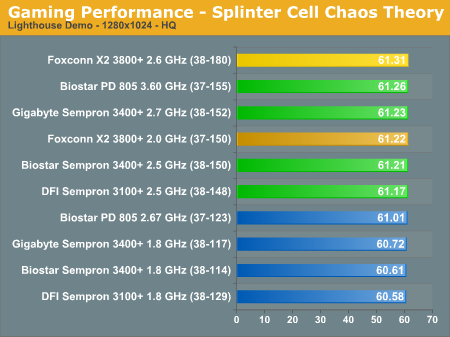
We could have continued running additional benchmarks, but basically it's pretty clear that the 7600 GT has reached its limits in many of the games with the overclocked processors. The good news is that all of the games were very playable at 1280x1024 resolution, so unless you demand things like antialiasing and higher resolutions, this graphics card should be sufficient. In fact, quite a few games can even run well with antialiasing enabled and/or higher resolutions.
Far Cry, Serious Sam 2, Quake 4, and Battlefield 2 all benefit from having a faster processor, but you can see that the graphs begin to flatten out at the top. (We're not quite sure what's going on with the X2 Battlefield 2 performance, but repeated testing garnered the same results. Apparently, that particular game really does well on the X2 chips.) Upcoming titles will likely require more graphics processing power, but in the future you will also be able to upgrade to a faster GPU for less money than that level of performance currently costs. The two SMP aware games that we tested showed differing results. Call of Duty 2 simply taxes the graphics card too much to really benefit from a faster processor. Quake 4 on the other hand shows some significant performance improvements, though once we enabled antialiasing most of those disappeared.
Taking a look at the performance offered by the various platforms, all of the overclocked systems perform very well. Without overclocking, the Sempron AM2 system is surprisingly at the bottom of the list when we used the Biostar motherboard, which is why we also tested with the Gigabyte board. The difference isn't huge, but the Gigabyte board is almost always 3% to 10% faster at the same clock speed and memory settings. This almost certainly points to a less optimized BIOS in the Biostar board, which isn't too surprising as most optimization efforts are focused on the enthusiast motherboards rather than the value offerings.
While historically AMD's K8 architecture has outperformed Intel's NetBurst architecture in games, the Pentium D 805 generally places ahead of the two Sempron chips, even with the slower front side bus. It would appear that the reduced L2 cache on the Sempron chips versus the larger L2 cache on the Pentium D results in the 805 being better overall for gaming. NetBurst has always done very poorly with reduced amounts of L2 cache (just take a look at the performance of the Celeron chips), but with the budget priced Smithfield core Intel jumps back into the lead for this price point.
Looking at the overclocked results again, most of the scores are in line with what we expected. Sempron AM2 is able to surpass Sempron 754 when we're not GPU limited, due at least in part to the higher clock speed we attained. It would also appear that higher clock speeds place more of a burden on system memory, so the dual channel memory comes out ahead. We would expect Sempron AM2 to be better overall, as it runs on a newer platform and we used a more expensive processor. Really, though, if you already have a decent 754 system, upgrading certainly isn't required (yet). If Athlon X2 on socket 939 wasn't enough to get you to upgrade, Athlon X2 on AM2 doesn't change things much.
The big question here is whether or not the CPU is going to be the bottleneck with the selected graphics card. As you'll see, the processor can be a limiting factor in the stock systems, depending on the game, but once we start overclocking everything begins to even out.









We could have continued running additional benchmarks, but basically it's pretty clear that the 7600 GT has reached its limits in many of the games with the overclocked processors. The good news is that all of the games were very playable at 1280x1024 resolution, so unless you demand things like antialiasing and higher resolutions, this graphics card should be sufficient. In fact, quite a few games can even run well with antialiasing enabled and/or higher resolutions.
Far Cry, Serious Sam 2, Quake 4, and Battlefield 2 all benefit from having a faster processor, but you can see that the graphs begin to flatten out at the top. (We're not quite sure what's going on with the X2 Battlefield 2 performance, but repeated testing garnered the same results. Apparently, that particular game really does well on the X2 chips.) Upcoming titles will likely require more graphics processing power, but in the future you will also be able to upgrade to a faster GPU for less money than that level of performance currently costs. The two SMP aware games that we tested showed differing results. Call of Duty 2 simply taxes the graphics card too much to really benefit from a faster processor. Quake 4 on the other hand shows some significant performance improvements, though once we enabled antialiasing most of those disappeared.
Taking a look at the performance offered by the various platforms, all of the overclocked systems perform very well. Without overclocking, the Sempron AM2 system is surprisingly at the bottom of the list when we used the Biostar motherboard, which is why we also tested with the Gigabyte board. The difference isn't huge, but the Gigabyte board is almost always 3% to 10% faster at the same clock speed and memory settings. This almost certainly points to a less optimized BIOS in the Biostar board, which isn't too surprising as most optimization efforts are focused on the enthusiast motherboards rather than the value offerings.
While historically AMD's K8 architecture has outperformed Intel's NetBurst architecture in games, the Pentium D 805 generally places ahead of the two Sempron chips, even with the slower front side bus. It would appear that the reduced L2 cache on the Sempron chips versus the larger L2 cache on the Pentium D results in the 805 being better overall for gaming. NetBurst has always done very poorly with reduced amounts of L2 cache (just take a look at the performance of the Celeron chips), but with the budget priced Smithfield core Intel jumps back into the lead for this price point.
Looking at the overclocked results again, most of the scores are in line with what we expected. Sempron AM2 is able to surpass Sempron 754 when we're not GPU limited, due at least in part to the higher clock speed we attained. It would also appear that higher clock speeds place more of a burden on system memory, so the dual channel memory comes out ahead. We would expect Sempron AM2 to be better overall, as it runs on a newer platform and we used a more expensive processor. Really, though, if you already have a decent 754 system, upgrading certainly isn't required (yet). If Athlon X2 on socket 939 wasn't enough to get you to upgrade, Athlon X2 on AM2 doesn't change things much.










56 Comments
View All Comments
Calin - Wednesday, July 12, 2006 - link
We were promised reviews of micro ATX mainboards a while back (hopefully with integrated video performance too, dual and single channel :) ). The article should be in the works now.Anyway, none of the integrated graphics/microATX boards I looked upon (from MSI, Asus etc) did have anything in the way of overclocking/overvolting/undervolting/...
I'm waiting, thanks
Rix2357 - Monday, July 10, 2006 - link
Most of these motherboards are decently cheap, but I wonder if they are as stable as some more well established brands. Of course, I go way back and a mantra that I've heard over and over, for stability Asus and Intel motherboards are the only way to go. While the DFI board in the test could be reasonably expected to be relatively stable, I am unsure about the biostar motherboard.My case in point from way back. The ECS K7S5A motherboard for a Socket A Athlon motherboard was supposedly one of the best, but it still had it's quirks. It's no where near as stable as the Asus Williamete motherboard at that time. It also has cold boot issues that numerous different bioses have never fixed. Hard drive detection with a third party IDE controller could be problematic at best.
Calin - Wednesday, July 12, 2006 - link
I have an ECS K7S5A mainboard, and its stability was good. Anyway, that was around the time when even top mainboards had one or two errors in 72 hours of benchmarks/stability checks.I would say Gigabyte boards are good too - I've had not so positive experiences with Foxconn boards.
JarredWalton - Monday, July 10, 2006 - link
The Biostar + PD805 has been in use for roughly six months, without any noticeable problems. The DFI Infinity has also been in use for a while without problems. AM2 is too new to say how it is in terms of stability, but I definitely enjoy the extra features (because I am one of those people that has GbE running through the house). If your primary concern is stability, you'd probably want to skip out on overclocking anyway. One of the biggest difficulties in overclocking is determining long-term "stable" settings. It can take months to get what you feel is an optimally stable system, and minor tweaks to voltages, memory timings, bus speeds, etc. can turn a crash-prone system fully stable (or vice versa).Avalon - Monday, July 10, 2006 - link
If these are budget considerations, why is 2-2-2 DDR memory and an XXX XFX listed in there? You can get an eVGA 7600GT CO for less than $150AR from time to time, and 1GB of CAS 2.5 memory will only set you back $90 and be practically as fast. That's $60 saved.Gary Key - Monday, July 10, 2006 - link
Jarred explained this on page 2. The memory selected for the S754 system is what we had available at the time for 2-2-2 operation. You are right that additional money could be saved for a minor performance delta. Since this article was looking at budget gaming performance, the XFX video card was chosen since it was still in our price range and is factory overclocked allowing a small increase in performance for those uncomfortable with overclocking the GPU. We mentioned that with rebates just about any of the 7600GT cards could be had for around $140~$160.
This article was designed to provide an umbrella look at what is available in the $650 price range and how it performs with today's game titles. We certainly understand that additional money could be saved or could be spent depending upon the individual's objective in building a system. As an example, on the S754 system you could have spent a little less on the memory but could have taken those savings and applied them to a better audio solution resulting in the same end figure. Some people would rather have the improved memory performance and live with the on-board audio. In the end, for about $650 you can build a decent machine today and there are an incredible amount of component choices that allow you to do this.